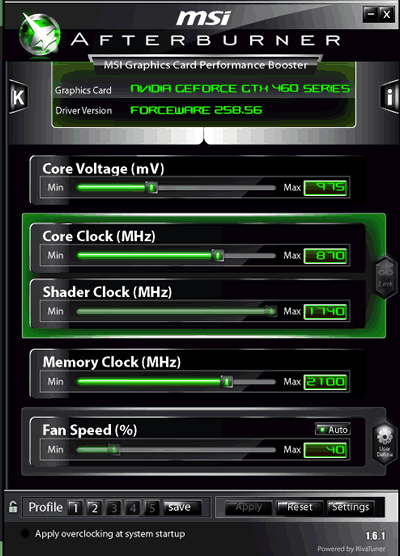Inno3D GTX 460 768MB review
8. Dirt 2 (DX 11), Alien Vs Predator Benchmark v1.03 (DX 11), Overclocking
Review Pages
2. Meet the Inno3D GTX 460 768MB
3. How we test
4. FutureMark Hall Of Fame
5. Crysis Warhead, S.T.A.L.K.E.R: Call Of Pripyat Benchmark
6. Company Of Heroes v1.71 (DirectX 10)
7. Far Cry 2 (DX 9/10), Left4Dead (DX 9), StreetFighter IV (DX 9), Unigine Engine (DX10)
8. Dirt 2 (DX 11), Alien Vs Predator Benchmark v1.03 (DX 11), Overclocking
9. Conclusion
- Dirt 2 (DirectX 11)
Colin McRae: Dirt 2 (known as Dirt 2 outside Europe and stylised, DiRT) is a racing game released in September 2009, and is the sequel to Colin McRae: Dirt. The game runs on an updated version of the EGO engine, which powered Codemasters' Race Driver: Grid as well. The engine features an updated physics engine and makes pretty through use of the DX11’s tessellation abilities.

We installed the the game patch and measured the in-game performance of the Inno3D GTX460 768MB graphics card at 1920x1200 and with the AA enabled:

Here the Inno3D GTX 460 768MB performed slight better than the GTX 465 series. Of course, such small differences have not any actual meaning.
- Alien vs Predator Benchmark v1.03 (DirectX 11)

Rebellion has released a standalone DirectX 11 PC benchmark test based upon its shooter Aliens vs. Predator. The benchmark test requires a graphics support supporting DirectX 11, which are used to produce such fancy features as tessellation, advanced shadow sampling and DX11 anti-aliasing.
We used the default settings of the benchmark (resolution: 1920 x 1200, Texture Quality: 2, Shadow Quality: 3, Anisotropic Filtering: 16, SSAO: ON, Vertical Sync: OFF, DX11 Tessellation: ON, DX11 Advanced Shadows: ON, DX11 MSAA Samples: 1).
The Inno3D GTX 460 768MB gave an average FPS of 29.60. The Gainward GTX 465 GOOD edition falls to even the GTX 460 768MB here by a frame.
- Overclocking
Finally, we are ready to test the overclocking abilities of the Inno3D GTX460 768MB. NVIDIA is heavily promoting the overclockability of the card to the press, proclaiming that they are regularly able to get most cards up to 800MHz.
For our overclocking we used the MSI AfterBurner 1.6x utility, which also unlocks the card's voltages allowing further tweaking. We enabled the 'Core Voltage' slider (though the 'settings' tab). The Core Voltage slider can go up to 1.087V to further increase the overclocking margins. The 'Core' and 'Shader' sliders are synched and move as one, allowing you to play with the 'Memory' slider as well. The package also includes the 'MSI Kombustor' application that stresses your graphics card and test its stability.
The Inno3D GTX460 reached the 870/1740/2100 MHz (core/shader/memory). We remind you that the card's stock clocks are 625/1350/3600 MHz. The system was stable and this was confirmed using both the MSI Kombustor and retail gaming, with the fan speed set to 'Auto.' Under that kind of overclocking, the fan speed running at 40% . This means that the GTX 460 experiences a minor rise in temperature, at least when overclocking without voltage modification.
It seems that Nvidia's argues the GTX 460’s overclocking capabilities are right. Of course, not every GTX 460 can hit 800MHz+.
We also measured the overclocked performance of the Inno3D GTX 460 graphics card. We got some pretty good FPS using the Far Cry 2 benchmark. Of course, the overall the impact of overclocking is heavily game dependent. Core overclocking favors games that are ROP/shader limited and has little effectiveness on games that are limited by the total available RAM or by memory bandwidth. As a result, overclocking was not so effective in games such as the Crysis and STALKER.
So generally, getting a card with more memory onboard (1GB) would make more sense for most of the games, instead of overclocking a card with less VRAM.


